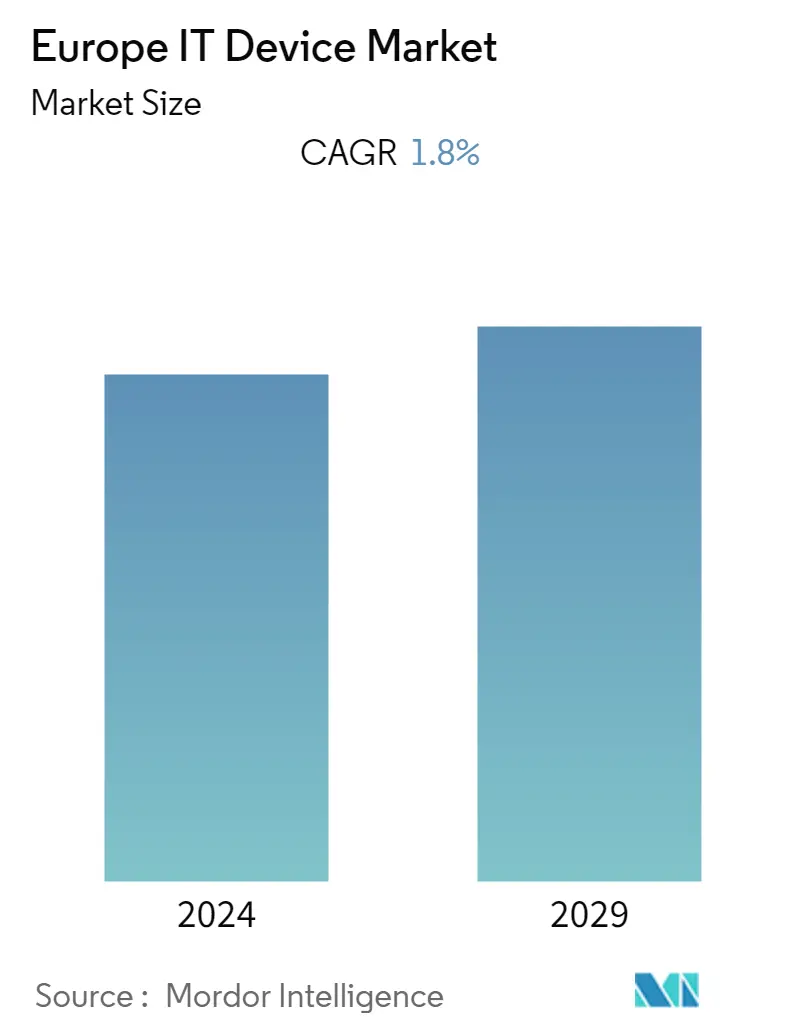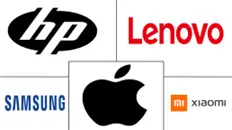Market Size of Europe IT Device Industry

| Study Period | 2019 - 2029 |
| Base Year For Estimation | 2023 |
| Forecast Data Period | 2024 - 2029 |
| Historical Data Period | 2019 - 2022 |
| CAGR | 1.80 % |
| Market Concentration | Low |
Major Players
*Disclaimer: Major Players sorted in no particular order |
Need a report that reflects how COVID-19 has impacted this market and its growth?
Europe IT Device Market Analysis
The European IT device market is expected to register a CAGR of 1.8% for the next five years. The IT device market is expanding due to increased demand for smartphones and increased shipment of ultra-light notebooks throughout the region.
- HP Inc. and Lenovo are the industry leaders in the European PC hardware market, holding a combined market share of almost 50%. Other well-known manufacturers include Dell, Acer, Asus, and Apple. HP Inc. and Lenovo again hold around half of the market when focusing only on PC shipments in Western Europe. In terms of tablet devices, Apple and Samsung are the top two providers in the European area, with Lenovo, Huawei, and Microsoft also prominent. As a result, Android and iOS are the operating systems that power over 90% of the region's tablet market.
- Nowadays, mobile phones are used almost everywhere in everyday life.When compared to laptops and notebooks, portable devices are used more frequently to connect to the internet. Mobile devices have largely replaced conventional items like watches and alarm clocks in Sweden, Denmark, and Norway as a tool for necessities like telling the time, setting the alarm, and taking pictures. Similar trends may be seen in the United Kingdom, where electronic device usage is strong, especially for computers, smartphones, and mobile phones.
- Inflation is difficult to ignore, especially given some forecasts that it could reach nearly 18% early next year, and it is already affecting people in the PC device industry. The effects of both inflationary pressures and the continued Chinese shipment challenges were evident from a review of PC shipments across Western Europe in the second quarter. In general, inflation has gone up across Europe, which is making people think twice as they prepare for a possible pay cut.
- Last year, there were more than 62 million smartphone users in Germany, making it a significant market for smartphone manufacturers. An estimated figure of nearly 20 million cell phones were sold nationwide in the current year. Approximately 75.6 million individuals are anticipated to own smartphones in Germany by 2024. As of January this year, Apple and Samsung had the highest smartphone share in the country.
- Due to the region's flexibility in responding to COVID, Western Europe has been a steadfast market for PC makers over the past two years. Although the PC shipment fell slightly from the current year's first quarter, it is still higher than the pre-pandemic level. Commercial demand is high as several marketplaces formally transition to business as usual market for PC makers over the past two years. Although the PC shipment fell slightly from the current year's first quarter, it is still higher than the pre-pandemic level. Commercial demand is high as several marketplaces formally transition to business as usual. The year 2021 was surprising for the European smartphone market. Early indications were encouraging that the market was rebounding from a challenging time when the COVID-19 epidemic hit the region hard and caused problems on both the supply and demand sides. Consequently, while the European smartphone market did increase by approximately 8% in the last year, this was only a partial recovery.
